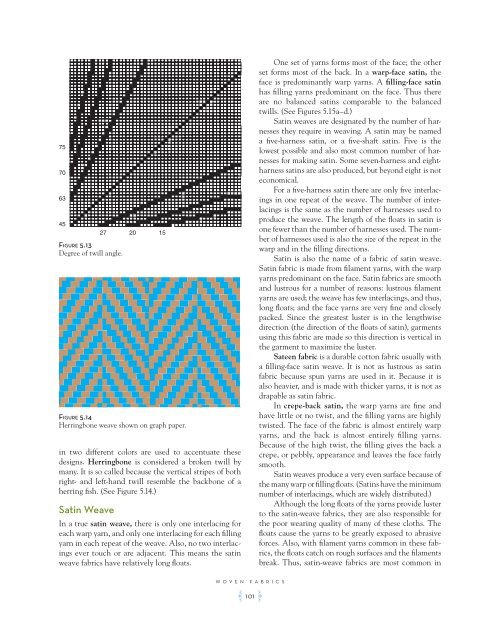You also want an ePaper? Increase the reach of your titles
YUMPU automatically turns print PDFs into web optimized ePapers that Google loves.
75<br />
70<br />
63<br />
45<br />
Figure 5.13<br />
Degree of twill angle.<br />
in two different colors are used to accentuate these<br />
designs. Herringbone is considered a broken twill by<br />
many. It is so called because the vertical stripes of both<br />
right- and left-hand twill resemble the backbone of a<br />
herring fish. (See Figure 5.14.)<br />
Satin Weave<br />
27 20 15<br />
Figure 5.14<br />
Herringbone weave shown on graph paper.<br />
In a true satin weave, there is only one interlacing for<br />
each warp yarn, and only one interlacing for each filling<br />
yarn in each repeat of the weave. Also, no two interlacings<br />
ever touch or are adjacent. This means the satin<br />
weave fabrics have relatively long floats.<br />
WOVEN FABRICS<br />
A 101 F<br />
One set of yarns forms most of the face; the other<br />
set forms most of the back. In a warp-face satin, the<br />
face is predominantly warp yarns. A filling-face satin<br />
has filling yarns predominant on the face. Thus there<br />
are no balanced satins comparable to the balanced<br />
twills. (See Figures 5.15a–d.)<br />
Satin weaves are designated by the number of harnesses<br />
they require in weaving. A satin may be named<br />
a five-harness satin, or a five-shaft satin. Five is the<br />
lowest possible and also most common number of harnesses<br />
for making satin. Some seven-harness and eightharness<br />
satins are also produced, but beyond eight is not<br />
economical.<br />
For a five-harness satin there are only five interlacings<br />
in one repeat of the weave. The number of interlacings<br />
is the same as the number of harnesses used to<br />
produce the weave. The length of the floats in satin is<br />
one fewer than the number of harnesses used. The number<br />
of harnesses used is also the size of the repeat in the<br />
warp and in the filling directions.<br />
Satin is also the name of a fabric of satin weave.<br />
Satin fabric is made from filament yarns, with the warp<br />
yarns predominant on the face. Satin fabrics are smooth<br />
and lustrous for a number of reasons: lustrous filament<br />
yarns are used; the weave has few interlacings, and thus,<br />
long floats; and the face yarns are very fine and closely<br />
packed. Since the greatest luster is in the lengthwise<br />
direction (the direction of the floats of satin), garments<br />
using this fabric are made so this direction is vertical in<br />
the garment to maximize the luster.<br />
Sateen fabric is a durable cotton fabric usually with<br />
a filling-face satin weave. It is not as lustrous as satin<br />
fabric because spun yarns are used in it. Because it is<br />
also heavier, and is made with thicker yarns, it is not as<br />
drapable as satin fabric.<br />
In crepe-back satin, the warp yarns are fine and<br />
have little or no twist, and the filling yarns are highly<br />
twisted. The face of the fabric is almost entirely warp<br />
yarns, and the back is almost entirely filling yarns.<br />
Because of the high twist, the filling gives the back a<br />
crepe, or pebbly, appearance and leaves the face fairly<br />
smooth.<br />
Satin weaves produce a very even surface because of<br />
the many warp or filling floats. (Satins have the minimum<br />
number of interlacings, which are widely distributed.)<br />
Although the long floats of the yarns provide luster<br />
to the satin-weave fabrics, they are also responsible for<br />
the poor wearing quality of many of these cloths. The<br />
floats cause the yarns to be greatly exposed to abrasive<br />
forces. Also, with filament yarns common in these fabrics,<br />
the floats catch on rough surfaces and the filaments<br />
break. Thus, satin-weave fabrics are most common in













